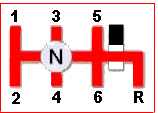 |


 |
| A
Real Sport Engine
|
 |
The Type R has the same 2.0L DOHC
I-VTEC engine as powered in the Integra IS model. New engine series DOHC i-VTEC
of Honda is intelligent engine which raises torque, mpg, and releases low
emission exhaust gas. However, certain components such as the cylinder heads
have been exclusively designed for this version of the Type R. Honda has paid
special attention to the casting process for these parts that gives a
|
big improvement in the
efficiency of intake and exhaust cycles. The extra efficiency has meant a more
aerodynamic effect in the overall combustion process and thus a dramatic
improvement in the engine power output and performance of the Type R.
[Optimum Gear
Shiftpoint Curve]
|
|
 |
|
A Light-weight Forged
Chrome-Molybdenum Steel Flywheel
|
| A super-light flywheel made of
chrome-molybdenum steel gives the Type R a smoother power transition between
the K20A engine and the Type-R close-ratio 6-speed transmission. The lightened
flywheel improves both the feel and performance of the engine. It gives an
instant response at any sudden throttle, when acceleration is demanded at any
time as driver steps on the metal pedal. It reduces about 0.3 seconds in
accelerating from 0 to 100 km/h, which equals to a reduction of 50 kg in the
car weight.
|
|
 |
|
The newest safe structure, a RVS
selection control system
|
 |
The DC5 uses a
speed-sensored solenoid-type selection lock, RVS selection control system, same
system adopted by NSX. When vehicle speed exceeds 20 km/h (~12 mph), the
solenoid will be set to ON, a cam will be locked and the selection operation to
a reverse gear becomes impossible, so a shift mistake can be prevented.
|
|
 |
|
A multi-corn synchronization
mechanism is adopted as the first in the world in a 2-litre classes
|
| In order to reduce the load at the
time of shift operation, it is effective to raise synchronization capacity. The
DC5 adapts multi-corn synchronization, using triple corn for 1st and 2nd gear
and double corn for 3rd to 6th gears. About 10% increase in diameter size was
attained simultaneously. Shift load decreases now and pleasant operation can be
enjoyed with a crunching sound. Moreover the rubber of the joint portion of a
gearshift has a stopper structure which gives a rigid combination. The shift
load between 2nd and 3rd gear has acquired about 5 kgf(s), a lighter value
comparing to 7 kgf(s) by Toyota Celica 6MT and 6 kgf(s) by S2000. Although it
was common that the shift load of a sports car is heavy, by Type R, such a
concept is swept away by adoption of a multi-corn synchronization. It is
decided invigoratingly lightly. The so-called "sports car which does not sweat"
was made.
|
|
 |
|
Variable path Exhaust pipes
|
 |
The Type-R equips a new exhaust
muffler that is constructed of variable pipes. The design can change silence
priority by leading exhaust gas flow to variable paths with a silencer. At a
low rpm region, silence priority becomes first. Sound is reduced and air
current is reduced at the same time. As engine speed reaches near the 5,000
rpm, higher exhaust gas output becomes the priority that desires less back
pressure. This design bumps up an extra 4 hp and 0.8 kg-m, than the predecessor
model. Comparing at 8,000 rpm, about 1/3 of
backpressure remains, therefore a large improvement
|
| in the power output was
achieved at the dual e-type exhaust pipe. Moreover, sport nature was emphasized
by the adoption of a larger diameter finish.
|
|
 |
|
A Clutch Start System
|
| The DC5 has adopted the clutch start
system as safety is measured from the time of engine starting. If the clutch
pedal is not stepped on, the protection does not allow engine to start into
operation.
|
|
 |
|
Reducing body inertia moment
|
| The front lower arm using aluminum
forged material allows an effective weight reduction, each decreased by 1.6kg.
The DC5 front and rear-end body is also strengthened by employing aluminum
material for the bumper beam and floor crossing beam. A rear brake caliper is
also aluminized. From the center of gravity, lightened components reduce the
overall inertia moment as much as possible. The handling response is increased.
|
|
 |
|
An Integration of a 4-port
Brembo Brake System into the Type-R
|
 |
The Type-R makes use of a Brembo
4-port brake system for the front. Brembo is well-known for its performance
braking systems for track racing and widely used on standard exotic sports cars
as their Original Equipment Manufacturer (OEM). By the physics of objects
during deceleration, it explains that a higher percent of the vehicle weight is
distributed towards the front in relative to the rear. As Type-R has a
front-mounted engine design, a higher front-to-rear weight distribution is
greatly compensated by the excellent Brembo 4-port brake system. To ensure
|
| braking performance and
reliability, the cooling capability is important for the brakes by more air
passing through. Honda has done a magnificent job integrating the Brembo brake
system into Type-R. By looking at the diagram, the brake cooling duct is
designed to let more airflow through the front spoiler directly to the brake
disc cooling, where the heat exchange takes place. The result of an extreme
continuous breaking test from 160 to 0 km/h shows a reduction of temperature at
the front brake pads by about 100 degree. Not only a fade proof nature but also
excellent vapor lock toughness has been achieved. The front and rear aluminium
brake caliper weighs about 2.3kg and 1.3kg respectively. Weight is an important
factor of improving extreme high performance cars.
|
|
|
|



